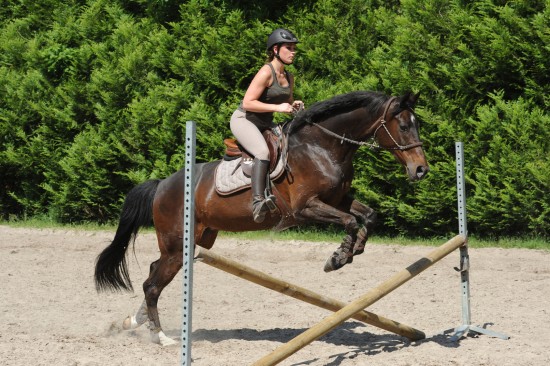

Many riders focus on their horse’s fitness and training, forgetting they are also integral to improving schooling results. A weak or unbalanced rider will not be able to control their weight in the movements, and lack the flexibility needed to make clear aids. If you plan to compete, you will also need to be as fit as your horse. There are many exercises you can do, to improve balance or weaknesses, come back stronger after an injury or just get ready for the show season.
Stretching is an easy way to help develop flexibility and loosen up muscles before you get on for your schooling session or hack. If you are stiff when you start the ride, your horse will also find it hard to stretch down, and warm up time will take longer. You will need to stretch each of the following body groups:
If you tire half way through a training session, you cannot expect your horse to improve the quality of its work. Eating healthily helps to fuel your muscles and improve your concentration. Take up a sport such as cycling, swimming or running. Set targets and goals so you are constantly pushing yourself, or join a club where you can have other people to help motivate you.
Cardiovascular work outs are the best way to strengthen your heart muscle. Cardio is when you elevate your heart rate between 55-85% of your maximum heart rate. To work out your resting heart rate, take your pulse when you wake up and count how many times it beats in a minute. Using a Target Health Rate calculator (See here), you will then know during your session if you are meeting your cardio target. Purchasing a watch with a heart rate monitor is the easiest way to check it without stopping. You should aim for a minimum of 10-20 minutes per session, increasing to an hour a day. That doesn’t have to be in one go however, so you can do multiple 20 minute sessions throughout the day.
The joy of cardio exercise is that there are many ways to increase heart rate – from the gym to household chores. Using a rowing machine or exercise bike is some of the best cardio you can find in a gym, and exercises a lot of the muscles you use when riding. Vacuuming and mowing the lawn are also useful and cheap ways to increase your heart rate, as long as you don’t stop in the middle for some tea!
Replacing your chair at home with a giant medicine ball is a great way to improve your centre of balance and strengthen your core muscles. Having to balance on the ball makes you have to distribute your weight evenly through your seat, and sit with equal pressure on both feet. Rolling the ball forwards and backwards can simulate the movement of a horse’s gait, with you having to adapt your back position and roll your hip bones to balance. It is quite a gentle exercise you can do while watching television, and helps you feel how you need to balance your body with the movement of the horses back.
A plastic football ball can also be used to develop your thigh muscles. Squeeze the ball between your knees and hold it for 10-20 seconds. Then release. Repeat this every day, increasing the number you can do in one sitting. This helps develop your inner thigh, which needs to be strong to help you use your seat to steer a horse.
Although this is riding, the difference is you do not need to consider the horse just your position. Most instructors will stand by you as you sit, correcting your position as you ride, evaluating your strengths and weaknesses. Being mechanical, you can then focus on exercises without worrying about hurting the horse or falling off.
Pilates is great for riders returning from injury, as it is very low impact. It focuses on controlling the body with small, deliberate movements. It helps to improve muscle strength, flexibility and improves breathing. Many of the exercises can be done while sat in the office, or watching the television, and don’t need a lot of equipment other than space. There are a growing number of horse riding Pilates teachers and books that focus on the muscles you need to improve, such as your core. As a result you can teach yourself, or get a specialised work routine from an expert to improve your individual weaknesses.
Yoga is slightly different to Pilates, although it also focuses on flexibility, strength and breathing techniques. Where Pilates is great for the core muscles, yoga is specifically good at strengthening lower legs and ankles. It also improves concentration through meditation. The benefit of Yoga is that there are many classes at local sports centres, ranging from novice to experienced.
Copyright © 2005-2016 Pet Information All Rights Reserved
Contact us: www162date@outlook.com